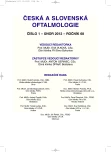Our Fifteen-Year Experience with Lasik
Authors:
S. Procházková; P. Novák; D. Klečka
Authors‘ workplace:
Refrakční Centrum Praha, s. r. o.
; Oční klinika Fakultní nemocnice Královské Vinohrady, Praha
přednosta prof. MUDr. Pavel Kuchynka CSc.
; Oční oddělení Nemocnice Na Homolce, Praha
primář MUDr. Petr Novák
Published in:
Čes. a slov. Oftal., 68, 2012, No. 1, p. 17-21
Category:
Original Article
Overview
Aim:
The authors report on results of correcting refractive errors by LASIK in patients suffering from low, middle and high myopia.
Method:
A retrospective comparative study.
Results:
The authors have been using this refractive method since 1996 and evaluate the postoperative outcome of their own work in the two refractive centers, equipped with sophisticated Instrumentation, in the period given above. Group B of years 2007–2010 compared to the older group A from 1999–2005 indicates a decrease in the variance of the results by 40–50 %, and moreover, in this set extreme results are virtually eliminated. In the case of the Uncorrected Visual Acuity (UCVA), the Best Corrected Visual Acuity (BCVA), the index of the effectiveness and safety similar mean values can be seen in both sets, but the variability was significantly greater among the older group A.
Conclusion:
On their groups of patients the authors present and compare on their groups of patients considerable long-term LASIK results, which confirm the effectiveness and safety of this refractive surgical procedure.
Key words:
LASIK, the effectiveness index, the safety index
Sources
1. Hammond, S.D., Puri, A.K., Ambati, B.K.: Quality of vision and patient satisfaction after LASIK, Curr Opinion Ophthalmol, 2004; 15: 328–332.
2. Hejcmanová M., Horáčková M.: Vliv laserového refrakčního zákroku LASIK na zrakové funkce u myopie. Čes a Slov Oftal, 62, 2006; 3: 206–217.
3. Hori-Komai Y.,Sakai C.,Toda I., Ito M, Yamamoto T., Tsubota K.: Detection of cyclotorsional rotation during excimer laser ablation in LASIK. J Refract Surg, 2007; 23: 911–915.
4. Chang J.: Cyclotorsion during laser in situ keratomileusis. J Cataract Refract Surg, 2008; 34: 1720–1726.
5. Kato N, Toda I, Hori-Komai Y, Sakai C, Tsubota K.: Five-year outcome of LASIK for myopia. Ophthalmology 2008; 115: 839–844.
6. Michael C. Chen, MD, Nancy Lee, Nirit Bourla, MD, D. Rex Hamilton, MD, MS: Corneal biomechanical measurements before and after laser in situ keratomileusis. J Cataract Refract Surg, 2008; 34: 1886–1891.
7. Netto, M.V., Ambrosio, R., Wilson, S.E.: Pupil size in refractive surgery candidates. J Cataract Refract Surg, 2004; 20: 337–342.
8. Randleman J.B., Woodward M., Lynn M.J., Stulting R.D.: Risk assessment for ectasia after corneal refractive surgery. Ophthalmology 2008; 115: 37–50.
9. Shoja MR, Besharati MR: Dry eye after LASIK for myopia: incidence and risk factors. Eur J Ophthalmol, 2007; 17: 1–6.
10. Tantayakom T., Lim J.N., Purcell T.L., Nalgirkar A, Cheng L, Schanzlin D.J.: Visual outcomes after wavefront-guided laser in situ keratomeleusis with and without iris registration. J Cataract Refract Surg, 2008; 34: 1532–1537.
11. Tjon-Fo-Sang MJ, de Faber J-THN, Kingma C, Beekhuis WH: Cyclotorsion: a possible cause of residual astigmatism in refractive surgery. J Cataract Refract Surg, 2002; 28: 599–602.
Labels
OphthalmologyArticle was published in
Czech and Slovak Ophthalmology

2012 Issue 1
Most read in this issue
- Gases in Vitreoretinal Surgery
- Floppy Eyelid Syndrome and Obstructive Sleep Apnoea
- Selected Prognostic Factors of Malignant Uveal Melanoma
- Comparative Study of Intraocular Pressure Measurements by Goldmann Applanation Tonometer, Noncontact Tonometer and TonoPen
